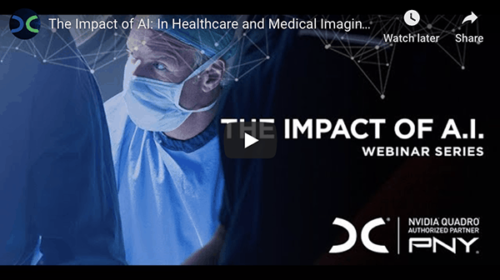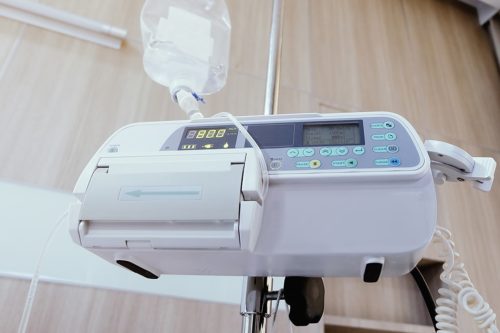Category Archive: Healthcare / Life Sciences
Artificial Intelligence in Healthcare is fundamentally changing how the world develops, deploys, and delivers compute intensive digital services and solutions. The impact of AI, deep learning and machine learning will be far greater than we can predict. Andrew Ng, Baidu’s former Chief Scientist, and a Stanford Adjunct Professor, noted, “Artificial intelligence is the new electricity.” We can say with confidence that utilizing AI is a business imperative that spans industries and markets planet wide.
This webinar series addresses how artificial intelligence in healthcare is forcing system integrators to address key challenges as the AI-revolution continues to advance and evolve at an increasing rate.
GPU Enhanced Medical Imaging Systems
Medical device design manufacturers continuously face regulatory challenges in addition to customer demands for improved performance, better features, improved image quality, and lowered acquisition costs. This webinar highlights how medical device manufacturers are utilizing GPUs to enable next generation imaging systems with AI enhanced diagnostic solutions to assist healthcare practitioners and provide better patient outcomes.
TOPIC: Impact of AI on Medical Imaging Devices and NVIDIA’s Quadro RTX Roadmap
PRESENTERS: Carl Flygare, NVIDIA Quadro Product Marketing Manager, PNY Technologies, and Jeff Krueger, Director of Systems Engineering, Dedicated Computing
DURATION: 28:52
Click Here to Watch this Webcast On-Demand

Medical System Development Costs are Better Defined by Lifecycle Management, Last Time Buys, and Long-Term Component Availability
 In the challenging and diverse realm of medical system design, not only do regulating agencies demand quality and compliance, but patients and doctors expect smart, connected health strategies. Systems must perform reliably in the spectrum of mission-critical healthcare environments, which may mean hospitals, doctors’ offices, in the home, or emergency settings. Global factors such as an aging population and the need for healthcare anywhere create even greater impact, keeping the market dynamic and continually evolving.
In the challenging and diverse realm of medical system design, not only do regulating agencies demand quality and compliance, but patients and doctors expect smart, connected health strategies. Systems must perform reliably in the spectrum of mission-critical healthcare environments, which may mean hospitals, doctors’ offices, in the home, or emergency settings. Global factors such as an aging population and the need for healthcare anywhere create even greater impact, keeping the market dynamic and continually evolving.
For manufacturers of healthcare medical devices, delivering on the promise of availability is just the beginning. Keeping systems in the field as long as possible is crucial for patient treatment as well as market leadership. Strategies for longevity must include both a design and support perspective and may require original equipment manufacturers (OEMs) to challenge the status quo.
Use Case: A start-up medical manufacturer scales change management
One medical design start-up, a developer of systems for fluorescence image-guided surgery, recognized smarter change management as a way to compete and win. Cashflow and reduced costs were critical to success, driving its focus on components with a strong balance of performance and longevity. In this scenario, the product lifecycle had to prove viable for long-term medical deployment by offering cost-effective, FDA-validated performance that would interest a buyer for the overall company.
This OEM recognized that any conversation around lifecycle management must also include total cost of ownership (TCO) and how it is defined. Once the team established a timeline for system development, they evaluated TCO as a complete picture. In this case, the OEM prioritized the need for insight into when component replacement should be expected and the associated cost.
This is a shift from a traditional look at TCO. Instead of simply outlining upfront system costs – and bidding supplier against supplier for pure component costs – the OEM sought proposals based on lifecycle management, last time buys, and long-term component availability. Newly empowered to evaluate system TCO over a full ten-year period, the OEM chose suppliers committed to meeting long-term needs and offering the best total cost.
To optimize planning and align its hardware Bill of Materials (BOM) with program needs, the OEM considered which software elements were right for its stack. This critical step acknowledges the software stack must not only accommodate the application software but must also be managed in the same way as the hardware stack. In addition, the OEM considered the lifecycle of each operating system (OS), which may affect system functionality and add validation cycles to system design.
In this scenario, the OEM recognized that evaluating and choosing an OS is equally as important as choosing ideal hardware components. Making a change to a piece of hardware impacts system certifications, but the OEM went further and considered whether it also affects the software image that goes on that device. Because upgrading and re-validating the software image presents a significant undertaking, this OEM embraced and anticipated the challenge, planning for it at the early stages of design. As a result, changes to hardware and software were slated to occur in tandem in the design or upgrade cycle. Re-validation is still significant but orchestrating it as a unified effort played a role in streamlining costs and engineering resources. The OEM saw competitive value by avoiding multiple re-validations that add cost and time to overall product resources.
Proactive Service Demands Real-time Insight Into Medical Device Performance, Balances Costs and Risk
Keeping healthcare systems in the field as long as possible is an exceptional demand for original equipment manufacturers (OEMs). Support strategies can play a critical role, recognizing security as a primary design requirement for connected devices. These concerns must be considered at the earliest stages of development rather than ‘bolted’ on later — which requires the understanding of implementation logistics and goals for achieving the right level of security – acceptable to the manufacturer as well as the device’s operational setting.
Security features can also be built into the software image, allowing systems to be online and less susceptible to security breaches. Early discussions, in advance of the software image being designed, can allow for a greater understanding of security features that may help the system achieve a higher threshold of protection while maintaining connectivity.
Use case: Early planning improves reliability and addresses security with a smart blend of remote and onsite support
One OEM of medical device equipment recognized a key support issue with its systems being returned noted as “no issue found.” Diagnosis was failing because the system was being removed from its environment and the repair depot could not replicate the problem. Remote options added great value here, as the manufacturer’s systems didn’t need to be removed from the field and could be diagnosed in their functional environment.
For this OEM, remote monitoring required connectivity, empowering the system operator with real-time insight on performance issues and system health. This facilitates proactive service, preventing failures before they happen – as well as highly focused service, tapping into better data to reduce costs for unnecessary service calls. Software updates can be handled remotely as well, eliminating the need for service techs to apply patches onsite using physical devices such as USB keys – for a significant cost savings.
At the same time, connectivity flies in the face of security concerns, potentially increasing vulnerability and risk that healthcare providers are keen to reduce and avoid. OEMs must base consideration of the preferred option on costs, comfort level and requirements of the deployment setting – as well as the likelihood of risk. For example, this OEM considered a hospital environment with a number of different infrastructure layers to navigate. In these types of scenarios, policies must be followed even as they vary from facility to facility. In some cases, security protocols may not even allow an IoT-enabled system to function as a connected device; early discussion of these risks and limitations is critical to a balanced and successful support strategy.
Prioritizing lifecycle for a healthy competitive edge
Reliable, long-term performance is crucial in medical equipment design. Nothing is more important to patients than acquiring reliable access to lifesaving treatment. And nothing is more powerful in establishing OEM leadership than creating a reputation for longevity of system performance. For greater insight on how Dedicated Computing is enabling the competitive vision and strategy of global healthcare OEMs, request a meeting with an engineer here.
In an era where unprecedented data breaches are affecting corporate and government entities, the devices used in hospitals and other medical settings represent an often overlooked, yet vital source of vulnerability. For years, security researchers have cautioned the healthcare industry about their exposed medical devices.
Too often these devices are internet-capable or networked internally without encryption technology, cloud computing safeguards, or even password protection. This makes them an easy target for hackers who have the ability to steal data, disable medical devices responsible for providing life-saving care, or launch a widespread cyber attack that can affect every device on a particular network.
The Food and Drug Administration issued new guidelines in 2014 covering medical devices in the market. These guidelines stated that all such devices should be secure, be able to easily update to correct any flaws, and have safeguards in place to protect care in the event the device is hacked or otherwise compromised. The guidelines also mandated that, ideally, medical devices should include the ability to be updated and be accompanied by a list of software components that would allow hospitals to check the device for any vulnerabilities.
A Constant Threat
 Infusion pumps make up almost half of all medical devices, according to the Zingbox 2018 Threat Report, making them the largest potential source of attack for cyber-related threats. Currently the industry standard is to segment these types of devices, which limits any potential cyber intrusions to an individual device. Yet, this practice also makes it more difficult to provide widespread automatic security updates to such devices.
Infusion pumps make up almost half of all medical devices, according to the Zingbox 2018 Threat Report, making them the largest potential source of attack for cyber-related threats. Currently the industry standard is to segment these types of devices, which limits any potential cyber intrusions to an individual device. Yet, this practice also makes it more difficult to provide widespread automatic security updates to such devices.
The individual operators and medical personnel themselves leave another unyielding source of vulnerability. The above study discovered that the most common security risks originated from user practice issues, which included using web browsers on medical workstations for personal online browsing, chatting, and downloading content.
The Way Forward
The FDA offers a series of recommendations to prevent and otherwise fortify medical devices against the life threatening and/or privacy violating compromises that can result from a targeted attack. These include preemptive mitigation of cybersecurity risks early before they can be taken advantage of by hackers, as well as adopting a coordinated vulnerability disclosure policy and practice. They also encourage healthcare providers to put policies and procedures in place that will enable them to understand and evaluate risks, and discover any vulnerabilities in equipment or software.
According to the guidelines, healthcare providers must also have a plan in place to not only mitigate threats, but to respond and recover quickly and efficiently to limit patient risk. IT personnel in healthcare must be empowered to locate and neutralize cybersecurity threats, which means they must have established procedures in place for discovery and elimination of vulnerabilities.
Finally, it is always incumbent upon those managing healthcare IT systems to apply the five core principles put forth in the 2014 NIST voluntary Framework for Improving Critical Infrastructure Cybersecurity:
- Identify
- Protect
- Detect
- Respond
- Recover
Cybersecurity for IoT and Beyond
The burden on the industry to protect medical devices is great. Those who produce and utilize medical devices need IoT development partners who will work with them through the life of their devices, rather than supplying a basic framework before abandoning them to configure and manage the updates and security threats or breaches that occur on their own.
Contact Dedicated Computing today to learn more about the cloud computing solutions that will keep your systems current and free of vulnerabilities to threats.
The systems and solutions we build here at Dedicated Computing enable our customers’ products; including highly scientific research and discovery instruments manufactured by leading OEMs in the life sciences industry. We work intimately with our customers to integrate the technology and connectivity solutions needed to drive today’s most exciting innovations.
Dedicated Computing’s integrated software and hardware platforms are crafted to meet particular performance and computational needs.
What is Genome Sequencing?
 Complete genome sequencing, also referred to as entire genome sequencing or whole genome sequencing, is an essential tool in modern microbiology. The genome sequencing process determines an organism’s complete genome in a single operation, breaking down the entire DNA sequence.
Complete genome sequencing, also referred to as entire genome sequencing or whole genome sequencing, is an essential tool in modern microbiology. The genome sequencing process determines an organism’s complete genome in a single operation, breaking down the entire DNA sequence.
Enhancing cancer diagnostics, decoding disease and drug functions, and even identifying the origins of epidemics in real time, genome sequencing has allowed medical professionals to pinpoint crucial medical details and improve healing and treatment options.
Genome Sequencing Technology and Integrated System Requirements
As the genome sequencing market makes its way into diagnostic and clinical laboratories on a large scale, original equipment manufacturers (OEMs) are developing the tools necessary to make this level of processing possible.
Generating and analyzing such vast quantities of information necessitate a range of sophisticated capabilities, including:
- Computing power and performance that can manage high data acquisition rates with the potential to add storage and reduce sequencing runtimes as needed
- Fast, efficient operations for quick time to market
- Improved reliability with proactive monitoring to prevent and correct failures, allowing for reduced downtime
- Minimized software stack vulnerability for fewer security threats
Assembling Custom Systems for Sequencing Technology
Powering the advanced applications of today’s genome sequencing market requires complex, customizable systems. Every element of this technology must be designed to meet the needs of high-volume data processing and analyzing, management, sequencing, and resequencing, with maximized efficiency and minimal operational risk of system downtime.
Below are some of the key components used in such integrated setups.
- Control processing, allowing for high productivity, increased cycle rates, and the ability to provide quick, precise performance
- Data/image processing, for converting raw data into accessible, meaningful information. For instance, data sets and sophisticated image libraries may be used in real-time to guide surgical procedures, maintain quality control, or batch-process materials
- Data storage solutions, to control a higher quantity of information than has ever been handled by previous technologies, and at higher risk; effective data storage solutions must stand up to cybersecurity standards, disaster recovery requirements, strict regulatory compliances, and much more
- Planning and viewing tools, allowing for integrated systems with camera interface cards, frame grabbers, digital I/O modules, and advanced color processing for increased accuracy and reliable performance in monitoring, measuring and evaluation, and data analysis
Enhanced Genome Sequencing Solutions From Dedicated Computing
Every custom system from Dedicated Computing is built upon our years of experience in the health care diagnostics industry. With computing expertise in acquisition products, network area storage, secondary/tertiary clusters, and much more, our team can provide a reliable solution for your exact needs.
To learn more about our services and support for enhanced genome sequencing solutions, or to request a quote for your specific application, reach out to the team today.
Originally published, April 30, 2018, from Embedded Intel® Solutions
In genomics, huge data files are generated, which are then broken down into thousands of smaller fragments for effective analytics. Today this kind of precision medicine is advancing because clinicians can access and interpret these data files—patient information in the form of genetic sequences—faster than ever. This is High Performance Computing (HPC) cluster technology at work, delivering remarkable benefits for individual patients and helping advance the field of genomics decades faster than originally anticipated. Where precision medicine was thought to have global impact by 2050, the new target is 2020. ‘One size fits all’ is no longer the standard of care, and HPC technology is poised to deliver higher value at lower costs in the widest range of research and treatment environments.
Tapping into Big Data Faster
It once took weeks to benefit from healthcare data—collaborating and sharing data from labs, medical records, pharmacies, insurance companies, and specialists, and then turning that information into well-informed treatment plans. HPC cluster architecture has cut this timeline down to a matter of hours. As exciting as that is, the real value is that this scalable, standards-based technology is accessible to hospitals, clinics, and labs of all sizes and resources, instead of just government labs and super-computing environments. On a global basis, the spectrum of healthcare innovators can tap into HPC to increase the value of data while significantly lowering their costs. Reactions to treatments are faster and more responsive, saving lives in all types of treatment settings.
To read the full article, visit the original published article here.


 In the challenging and diverse realm of medical system design, not only do regulating agencies demand quality and compliance, but patients and doctors expect smart, connected health strategies. Systems must perform reliably in the spectrum of mission-critical healthcare environments, which may mean hospitals, doctors’ offices, in the home, or emergency settings. Global factors such as an aging population and the need for healthcare anywhere create even greater impact, keeping the market dynamic and continually evolving.
In the challenging and diverse realm of medical system design, not only do regulating agencies demand quality and compliance, but patients and doctors expect smart, connected health strategies. Systems must perform reliably in the spectrum of mission-critical healthcare environments, which may mean hospitals, doctors’ offices, in the home, or emergency settings. Global factors such as an aging population and the need for healthcare anywhere create even greater impact, keeping the market dynamic and continually evolving. Infusion pumps make up almost half of all medical devices, according to the
Infusion pumps make up almost half of all medical devices, according to the  Complete
Complete